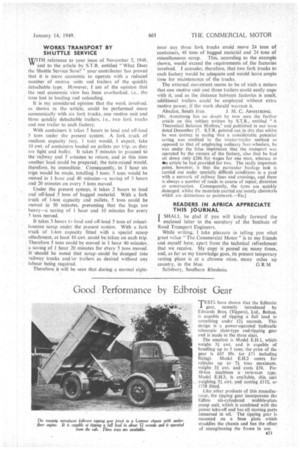WORKS TRANSPORT BY SHUTTLE SERVICE WITH reference to your issue
Page 55

If you've noticed an error in this article please click here to report it so we can fix it.
of November 5, 1948, " and to the article by S.T.R. entitled " What Does the Shuttle Service Save?" your contributor has proved that it is more economic to operate with a reduced number of motive anits and trailers of the quickly detachable type. However, 1 am of the opinion that the real economic view has been overlooked. i.e., the time lost in loading and unloading.
It is my considered opinion that the work involved. as shown in the article, could be performed more economically with six fork trucks, one motive unit and three quickly detachable trailers, i e.. two fork trucks and one trailer to each factory.
With containers it takes 5 hours to load and off-load 5 tons under the present system. A fork truck of medium capacity (say. I ton) would, I expect, take 10 cwt. of containers loaded on pallets per trip, as they are light and bulky. It takes 5 minutes to 'proceed to the railway and 5 toinutes to return, and in this time another load could he prepared; the turn-round would. therefore, be immediate. Consequently, in 1 hour six trips would he made, totalling 3 tons: 5 tons would be moved in I hour and 40 minutes—a saving of 3 hours and 20 minutes on every 5 tons moved.
Under the present system, it takes 2 hours to load and off-load 5 tons of bagged material. With a fork truck of 1-ton capacity and pallets, 5 tons could be moved in 50 minutes, presuming that the bags are heavy—a saving of 1 hour and 10 minutes for every 5 tons moved.
It takes 3 hours to load and off-load 5 tons of miscellaneous scrap under the plesent system. With a fork truck of I-ton capacity fitted with a special scoop attachment, at least IP cwt. could be taken on each trip. Therefore 5 tons could be moved in I hour 40 minutes. a saving of 1 hour 20 Minutes for every 5 tons moved. It should be noted that Scrap-could be dumped into railway trucks and/or trailers as desired without any labour being required.
Therefore it will be seen that during a normal eight
hour day three fork trucks could move 24 tons of containers, 48 tons of bagged material and 24 tons of miscellaneous scrap. This, according to the example shown, would exceed the tequirements of the factories involved. 1 consider, therefore, that two fork trucks to each factory would be adequate and would leave ample time for maintenance of the trucks.
The external movement seems to be of such a nature that one motive unit and three trailers could easily cope with it, and as the distance between factories is small, additional trailers could be employed without extra motive power, if the work should warrant it.
Abadan, South Iran J. M. C. ARMSTRONG.
(Mr. Armstrong has no doubt by now seen the further article on this subject written by S.T.R., entitled " A Theoretical Solution Misfires," and published in our issue dated December 17. S.T.R. pointed out in this that whilst he was correct in saying that a considerable potential saving was credited to the tractor-trailer method as opposed to that of employing ordinary four-wheelers, he was under the false impression that the transport was operated by the owners of the factory, also that he had set down only £286 for wages for one man, whereas in the article he had provided for two, The really important point, however, is that the particular .haulage task is carried out under specially difficult conditions in a yard with a network of .railway lines and crossings, and there is always a number of roads in course of repair, diversion or construction. Consequently, the tyres are quickly ,damaged. whilst the materials carried are mostly chemicals which are deleterious to paintwork.—Eo.1 READERS IN AFRICA APPRECIATE THIS JOURNAL SHALL be glad if you will kindly forward the I enclosed letter to the secretary of the Institute of Road Transport Engineers.
While writing. I take pleasure in telling you what great value "The Commercial Motor" is to my friends and myself here, apart from the technical refreshment that we receive. My copy is passed on many times, and, as far as my knowledge goes, its present temporary resting place is at a chrome mine, many miles up country, in the blue. G R. M Salisbury, Southern Rhodesia.




























































































